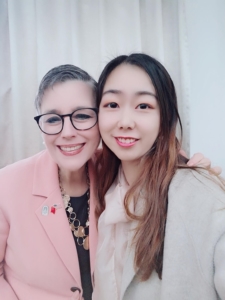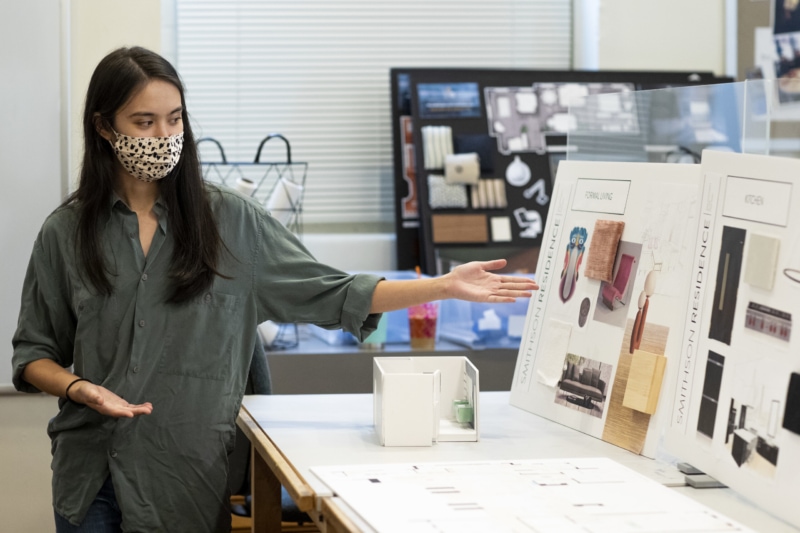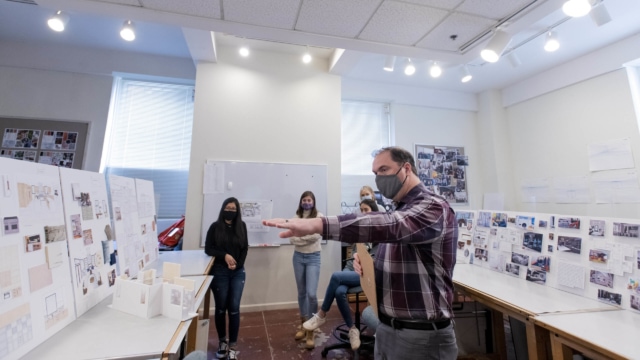Global perspectives
Cultural diversity drives concepts, ideas in interior design program
The jump of an eyebrow. The swiftest of smiles. A quiet “ah” that screams success.
These “sparks of clarity,” as Michael Kleeman calls them, are the moments the Brenau interior design professor enjoys most when teaching his international students and the culmination of hard work, creativity and cross-cultural collaboration.
“There are times when a student is struggling — maybe I say a word for something, and they say another word — but we are working toward the same thing,” Kleeman says. “But when they actually have something tangible in their hands, there’s a moment of clarity. There’s no more language barrier because it’s all about understanding.”
International students — including seven from China and one from Brazil — make up about 25% of the total enrollment in Brenau’s undergraduate interior design program, which was recently reaccredited by the Council for Interior Design Accreditation. This diversity of cultures, Kleeman and students say, often leads to a constructive sharing of concepts and ideas. “It definitely brings a varied perspective to the classroom,”
Kleeman says. “Our American students often ask, ‘Is this how things are in China?,’ while Chinese students have introduced elements to the American students, such as the auspicious cloud and dragon motifs. It’s a very interesting dynamic.”
Aisa Goforth, senior interior design major from Norcross, Georgia, says having different viewpoints in the classroom has made her a better student and also helped expand her worldview — one of the four portals of education on which Brenau’s curriculum is based.
“Being in the kind of classes where we critique and evaluate each other’s work, it’s very helpful to get other creative perspectives on ways to improve a design,” Goforth says. “Design trends or even rules can sometimes be regional, so it’s also interesting to learn about what buildings or homes are like in other countries.”
Goforth is among a handful of interior design majors who are also international ambassadors at Brenau. These student ambassadors provide support for their new Chinese classmates to aid in their transition to the university, which has led them to become a very tight-knit group — in the classroom and beyond.
During a dinner break in one evening class, the Chinese students taught the American students how to use chopsticks. The American students returned the favor by hosting a dinner for the Chinese students. And Goforth says it’s not uncommon for the interior design students to text each other at late hours for advice or to “just find comfort in knowing that you’re going through the same struggles as someone else.”

Though Chinese students continue to learn remotely, the closeness they share with their American classmates remains stronger than ever. Despite a global pandemic and 12-hour time difference, students like Angie Sanchez and Kanjun “Lilac” Xu still communicate regularly via email, text, video chats and social media.
The two made their first virtual connection in early 2020, when Xu was matched with Sanchez through the international ambassador program. They exchanged experiences relating to Chinese and American culture and education, and Xu was excited to learn Sanchez was also an interior design major.
“When I first met Angie, I hadn’t attended class at Brenau yet, so I learned a lot from her about interior design courses and how they differ from those in China,” Xu says. “She is very friendly and nice, and we still communicate. She is a very good friend of mine, and I am really happy to have met her.”
Sanchez, who is from Lawrenceville, Georgia, says Xu always makes a huge effort to reach out to her when she has questions about assignments or American culture. “Food is a popular topic,” Sanchez says. During one exchange, Sanchez shared photos of her home and dog. Sanchez laughs when recalling her friend’s response — “Oh, what a beautiful home” — because, really, Xu just wanted to talk about the dog.
“That was very nice,” Sanchez says. “She really liked getting to see a little bit more of me and my personality aside from just being an ambassador or classmate.”
Just as Brenau’s American students have stayed in touch with their overseas classmates, the interior design faculty has taken steps as well as to ensure Chinese students are fully supported while learning remotely.
Kleeman shares recorded lectures along with audio transcriptions so the Chinese students can easily translate the text, and a weekly supplemental class in the master’s program recaps lectures and provides an opportunity for students to workshop future projects. Also, students have been allowed to make recordings of presentations instead of sharing them live, giving them more time to translate what they want to say and fully get across all their ideas.
“Sometimes, students struggle a little bit with the language, just because they’re not fully immersed in it anymore,” Kleeman says. “Some of the students really made the most of the opportunity with these very nice presentations and hit on all the points.”
Xu says she appreciates the efforts Kleeman, Sanchez and others have made to support her and her Chinese classmates as they continue to learn remotely.
“I am really grateful for the friendly, warm and kind professors and friends at Brenau,” she says. “I can’t wait to see them again.”



